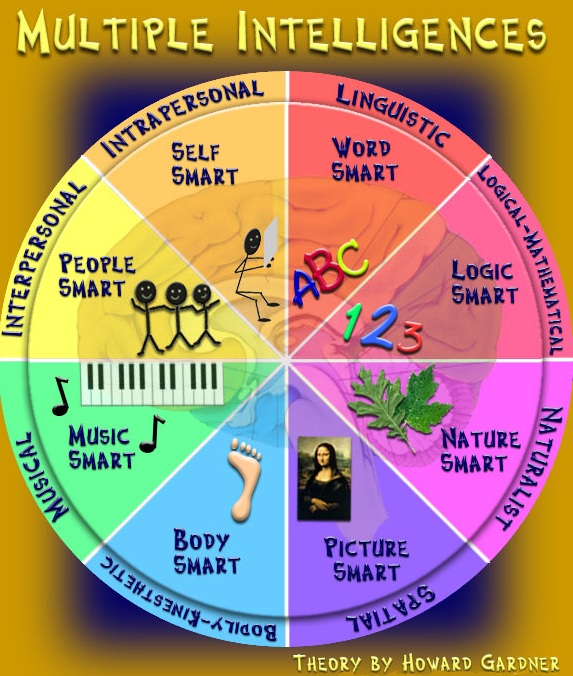How Are You Smart?

-Recently, I was asked to speak to students Years 8-10 at a school in NSW, Australia. The purpose was to encourage students to embrace a richness of life, learn with tenacity, and to increasingly take more responsibility for their learning. Given a 50-minute period, I approached this through a context of multiple intelligence and growth mindset. Following is a brief synopsis of my talk.
I begin by asking students about their dreams and aspirations, inviting them to ponder life goals in both occupation and leisure. Goals are important – and fun! Nothing great was ever achieved without goals, for they are the starting point for future planning. Planning and attentional effort is how we move toward our goals. For example, as a young pianist I dreamt of being a pianist on a fancy North Queensland tropical island. But dreaming is not enough. To enhance my prospects, I became aware that I would need to learn a large repertoire, become adept not only at reading music, but playing be ear, memorizing, and learning across a range of genres. More than 10 years later – for the road to exceptional performance is a long game, my dream came true. Yes, there is luck in being in the right place at the right time, but luck is when opportunity meets preparation. I practise to be ready for opportunities.
“How smart are you”? What do you think of this question? I don’t like it either. Anyway, what does “smart” mean? In the old days, it always referred to intelligence with numbers and words, and if one was not capable in these areas, they were labelled “dumb”. This is unfair and inaccurate. As we explored in the final part of my talk, you might not be good at something – yet, but it does not have to be permanent – unless, of course, you quit. Quitting makes failure permanent. Secondly, there are many ways to be intelligent, as outlined in Howard Gardner’s useful model of multiple intelligence. We can all participate in the richness of life, and improve our relationship with the world of numbers, words, music, spatial intelligence (art and design), kinaesthetic (sport, dance, cardio, movement) nature, self-knowledge and interpersonal relationships. Some people say things like “I’m a science person”, “not a reader”, “unmusical”, and so on, putting themselves in boxes. Parents do this with their children, too. I remind students that they do not have to be confined by stereotypes, labels and boxes. Einstein was a physicist but loved playing the violin and the piano. He was passionate about music. In other words, just because people might think you are “arty”, you can be sporty, or math-minded and so on. We want our children to explore the fullness of life without preconceptions of natural tendencies that might cripple effort.
I invite students to read out a description of each Gardner-identified intelligence, and the student cohort responds whether they identify with aspects of that intelligence. For example, music intelligence includes playing an instrument or singing, composing/making up songs, or responding as a listener. “If some of this is important to you, and you feel comfortable in this space, raise your hand.” As a form of identification, raising the hand is valuable because it requires students to commit to how they see themselves in the present moment.
At this point of my presentation, students have quiet time (possibly with me performing soft background piano music) to engage with a worksheet that allows them to explore more deeply, their present intelligence profile. They also select their “strongest intelligence” and weakest. I reinforce that this is only as it is presently, and that things can and do, change over time. Personal effort and persistence improve everything. Students – here’s ten two-letter words to write down: “if it is to be, it is up to me”. My example: as a younger person I feared public speaking and did few writing subjects at school. I decided to overcome my speaking phobia and start writing. As Susan Jeffers says in her book of the same name, feel the fear and do it anyway! And now what do I do for a living? I’m a public speaker and have written eight books.
Following the worksheet, students are invited to consider weaker areas of their intelligence profile. What would you like to improve? Hence, a good deal of discussion ensues on the greatest predictor of improvement in anything and everything: the quality and the quantity of personal effort. Other important factors get a mention: reading books, why writing is so good for you, physical movement, and how more sleep is related to better grades in school. I teach the children that in a sense, they are neurological engineers, in that their brain physically changes based on their actions, their repetitions That we become what we repeatedly do is a truism from Greek philosophy. What makes us smart is not the 86 billion neurons we were endowed with, but rather the 80-90 trillion connections constructed through attempts and action. No one was born a musician or a scientist. The growth mindset message of improvement through effort wins the day. Where’s the point where you can no longer improve at something? Forget “reaching potential”. We learn to continually broaden our potential. Ed Sheeran says, “forget talent – you really have to practise a lot”. Difficult? It’s unfamiliar, that’s all. Rather than “I can’t do this” – “I can’t do this – yet”.
Back to the students – what are three take-aways that are useful to you/interesting/ that make you really think?
The messages in this presentation are geared to middle-school students. They are positive, affirming, important, and serve to reiterate the school ethos. If you’d like this live presentation for your school, contact me, michael@professional-development.com.au. You can also read about these ideas in my book “Children and Learning: For Parents”.
Michael Griffin
March 3, 2022.
MICHAEL GRIFFIN
M. Ed Studies, B.Ed.
A. Mus. A
Adelaide, South Australia